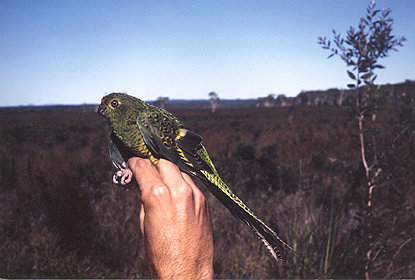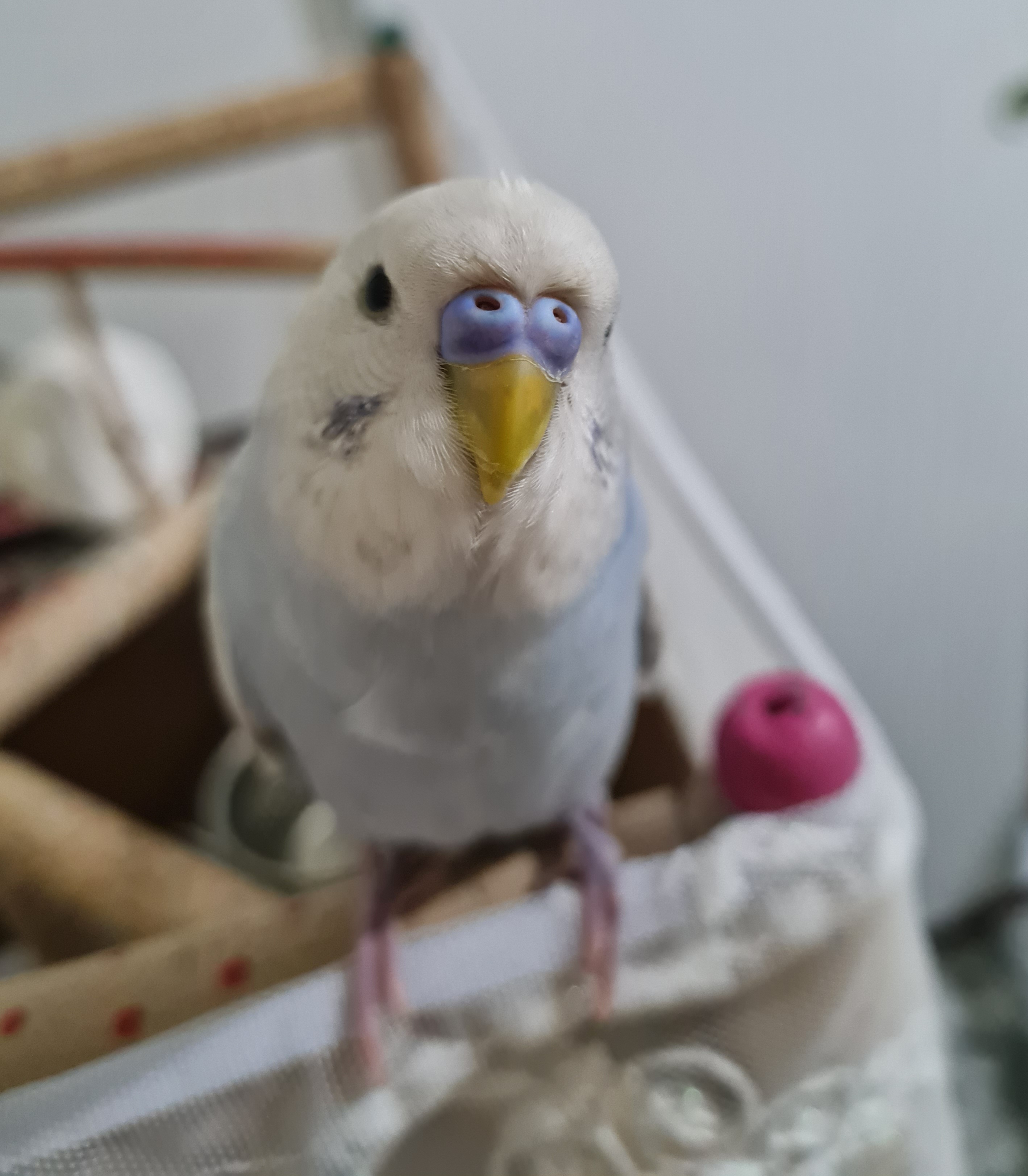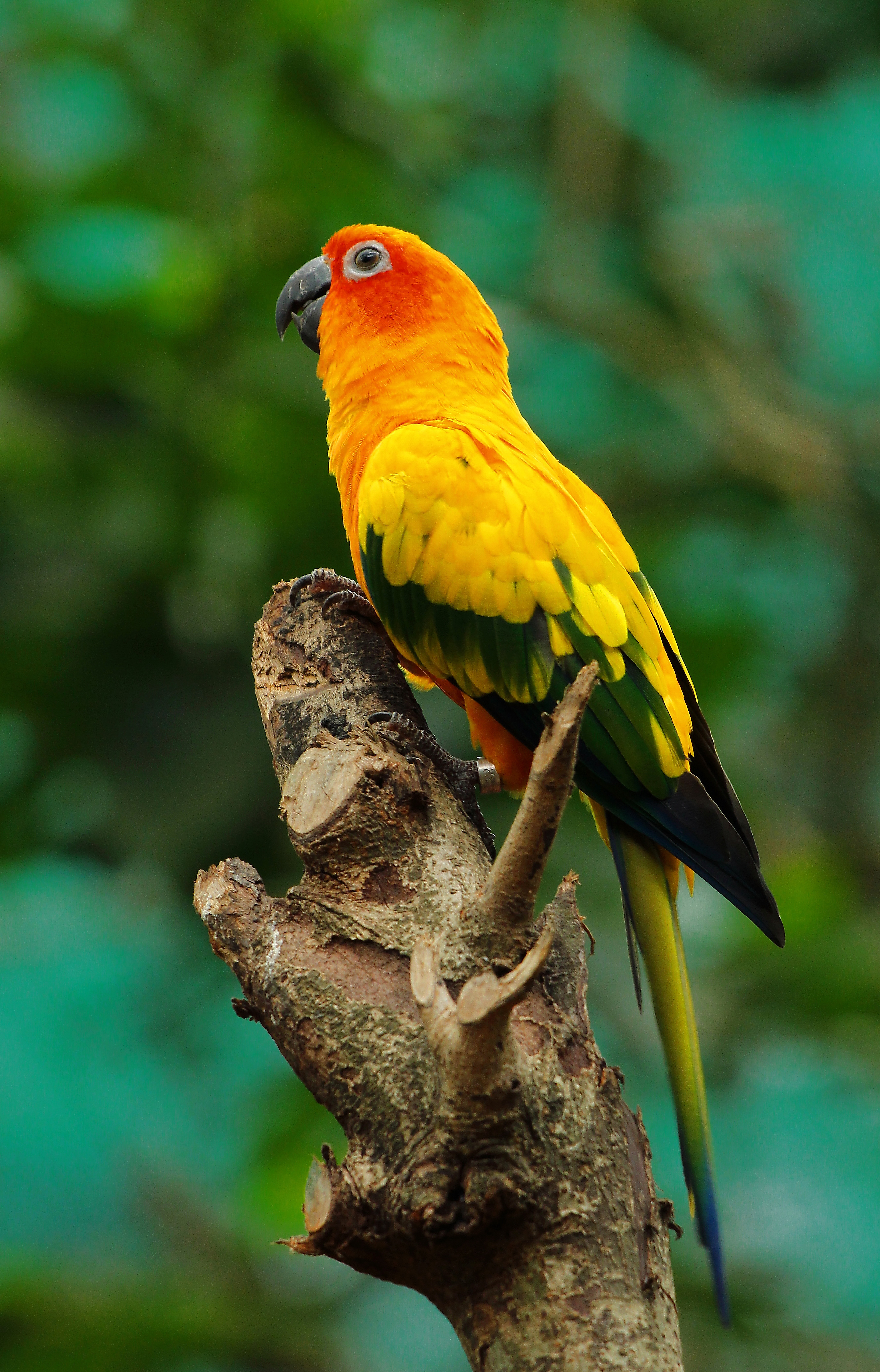|
True Parrot
The true parrots are about 350 species of hook-billed, mostly herbivorous birds forming the superfamily Psittacoidea, one of the three superfamilies in the biological order Psittaciformes (parrots). True parrots are widespread, with species in Mexico, Central and South America, sub-Saharan Africa, India, Southeast Asia, Australia, and eastwards across the Pacific Ocean as far as Polynesia. The true parrots include many of the familiar parrots including macaws, conures, lorikeets, eclectus, Amazon parrots, grey parrot, and budgerigar. Most true parrots are colourful and flighted, with a few notable exceptions. Overview True parrots have a beak with a characteristic curved shape, the jaw with a mobility slightly higher than where it connects with the skull, and a generally upright position. They also have a large cranial capacity and are one of the most intelligent bird groups. They are good fliers and skillful climbers on branches of trees. Some species can imitate the human ... [...More Info...] [...Related Items...] OR: [Wikipedia] [Google] [Baidu] |
Blue-and-yellow Macaw
The blue-and-yellow macaw (''Ara ararauna''), also known as the blue-and-gold macaw, is a large South American parrot with mostly blue top parts and light orange underparts, with gradient hues of green on top of its head. It is a member of the large group of neotropical parrots known as macaws. It inhabits forest (especially varzea, but also in open sections of ''terra firme'' or unflooded forest), woodland and savannah of tropical South America. They are popular in aviculture because of their striking color, ability to talk, ready availability in the marketplace, and close bonding to humans. They can also live for 65–70 years. Taxonomy The blue-and-yellow macaw was formally described by the Swedish naturalist Carl Linnaeus in 1758 in the tenth edition of his ''Systema Naturae''. He placed it with all the other parrots in the genus ''Psittacus'' and coined the binomial name ''Psittacus ararauna''. This macaw is now one of the eight extant species placed in the genus ''Ara' ... [...More Info...] [...Related Items...] OR: [Wikipedia] [Google] [Baidu] |
India
India, officially the Republic of India (Hindi: ), is a country in South Asia. It is the seventh-largest country by area, the second-most populous country, and the most populous democracy in the world. Bounded by the Indian Ocean on the south, the Arabian Sea on the southwest, and the Bay of Bengal on the southeast, it shares land borders with Pakistan to the west; China, Nepal, and Bhutan to the north; and Bangladesh and Myanmar to the east. In the Indian Ocean, India is in the vicinity of Sri Lanka and the Maldives; its Andaman and Nicobar Islands share a maritime border with Thailand, Myanmar, and Indonesia. Modern humans arrived on the Indian subcontinent from Africa no later than 55,000 years ago., "Y-Chromosome and Mt-DNA data support the colonization of South Asia by modern humans originating in Africa. ... Coalescence dates for most non-European populations average to between 73–55 ka.", "Modern human beings—''Homo sapiens''—originated in Africa. Then, int ... [...More Info...] [...Related Items...] OR: [Wikipedia] [Google] [Baidu] |
Antipodes Parakeet
The Antipodes parakeet or Antipodes Island parakeet (''Cyanoramphus unicolor'') is a parrot in the family Psittaculidae that is endemic to the Antipodes Islands of New Zealand. It is one of two parrot species found on the islands, and one of only five ground-dwelling parrots in the world. They are long-living birds that may live up to 10 years of age, but the introduction of mice that compete with them for food is a threat to their survival on the Antipodes Islands. Unusually for parrots, they sometimes prey upon other birds, a trait shared by another New Zealand parrot, the kea. Taxonomy The Antipodes parakeet was depicted in 1831 by the English artist Edward Lear in his ''Illustrations of the Family of Psittacidae, or Parrots''. Lear used the common name "Uniform parakeet" and coined the binomial name ''Platycercus unicolor''. The species is now placed in the genus ''Cyanoramphus'' that was introduced in 1854 by the French ornithologist Charles Lucien Bonaparte. Its closest rel ... [...More Info...] [...Related Items...] OR: [Wikipedia] [Google] [Baidu] |
Pezoporus
The genus ''Pezoporus'' contains three Australian species: the night parrot (''Pezoporus occidentalis'') and the cryptic ground parrots, the eastern ground parrot (''Pezoporus wallicus'') and the western ground parrot (''Pezoporus flaviventris''). The night parrot was previously separated in a distinct genus, ''Geopsittacus''. The genus is part of the tribe The term tribe is used in many different contexts to refer to a category of human social group. The predominant worldwide usage of the term in English is in the discipline of anthropology. This definition is contested, in part due to confli ... Pezoporini. Species list *Genus ''Pezoporus'' References Bird genera Broad-tailed parrots {{parrot-stub ... [...More Info...] [...Related Items...] OR: [Wikipedia] [Google] [Baidu] |
Budgerigar
The budgerigar ( ; ''Melopsittacus undulatus''), also known as the common parakeet or shell parakeet, is a small, long-tailed, seed-eating parrot usually nicknamed the budgie ( ), or in American English, the parakeet. Budgies are the only species in the genus ''Melopsittacus''. Naturally, the species is green and yellow with black, scalloped markings on the nape, back, and wings. Budgies are bred in captivity with colouring of blues, whites, yellows, greys, and even with small crests. Juveniles and chicks are monomorphic, while adults are told apart by their cere colouring, and their behaviour. The species is the only member of the genus ''Melopsittacus'', which is the only genus in the Melopsittacini tribe. The origin of the budgerigar's name is unclear. First recorded in 1805, budgerigars are popular pets around the world due to their small size, low cost, and ability to mimic human speech. They are likely the third most popular pet in the world, after the domesticated d ... [...More Info...] [...Related Items...] OR: [Wikipedia] [Google] [Baidu] |
Grey Parrot
The grey parrot (''Psittacus erithacus''), also known as the Congo grey parrot, Congo African grey parrot or African grey parrot, is an Old World parrot in the family Psittacidae. The Timneh parrot ''(Psittacus timneh)'' once was identified as a subspecies of the grey parrot, but has since been elevated to a full species. Taxonomy The grey parrot was Species description, formally described in 1758 by the Swedish naturalist Carl Linnaeus in the 10th edition of Systema Naturae, tenth edition of his ''Systema Naturae''. He placed it with all the other parrots in the genus ''Psittacus'' and coined the binomial nomenclature, binomial name ''Psittacus erithacus''. Linnaeus erroneously specified the type locality (biology), type locality as "Guinea": the locality was later designated as Ghana in West Africa. The genus name is Latin for "parrot". The specific epithet ''erithacus'' is Latin and is derived from the Ancient Greek εριθακος (''erithakos'') for an unknown bird that ... [...More Info...] [...Related Items...] OR: [Wikipedia] [Google] [Baidu] |
Amazon Parrot
Amazon parrots are parrots in the genus ''Amazona''. They are medium-sized, short-tailed parrots native to the Americas, with their range extending from South America to Mexico and the Caribbean. ''Amazona'' is one of the 92 genera of parrots that make up the order Psittaciformes and is in the family Psittacidae, one of three families of true parrots. It contains about thirty species. Most amazons are predominantly green, with accenting colors that depend on the species, and they can be quite vivid. They feed primarily on seeds, nuts, and fruits, supplemented by leafy matter. Many amazons have the ability to mimic human speech and other sounds. Partly because of this, they are popular as pets or companion parrots, and a small industry has developed in breeding parrots in captivity for this market. This popularity has led to many parrots being taken from the wild to the extent that some species have become threatened. The United States and the European Union have made the captu ... [...More Info...] [...Related Items...] OR: [Wikipedia] [Google] [Baidu] |
Eclectus
''Eclectus'' is a genus of parrot, the Psittaciformes, which consists of two known species, the eclectus parrot (''Eclectus roratus'') and the extinct ''Eclectus infectus'', the oceanic eclectus parrot. The extant eclectus parrot is a medium-sized parrot native to regions of Oceania, particularly New Guinea and Australia. Males are mostly bright green, females are predominantly bright red. The male and female eclectus were once thought to be different species. The conservation status of the remaining species is least concern. Eclectus parrots do well in captivity, and are a very popular pet across the world. Description Eclectus parrots generally have a big head and a short tail, and are striking in their coloration. They measure about 35–42 cm in length. They unusually exhibit reverse sexual dichromatism, a form of sexual dimorphism where the two sexes have differential coloration. Males are mostly green, with bright red underwings, blue primaries, and a yellow beak, ... [...More Info...] [...Related Items...] OR: [Wikipedia] [Google] [Baidu] |
Lorikeet
Loriini is a tribe of small to medium-sized arboreal parrots characterized by their specialized brush-tipped tongues for feeding on nectar of various blossoms and soft fruits, preferably berries. The species form a monophyletic group within the parrot family Psittaculidae. The group consists of the lories and lorikeets. Traditionally, they were considered a separate subfamily (Loriinae) from the other subfamily (Psittacinae) based on the specialized characteristics, but recent molecular and morphological studies show that the group is positioned in the middle of various other groups. They are widely distributed throughout the Australasian region, including south-eastern Asia, Polynesia, Papua New Guinea, Timor Leste and Australia, and the majority have very brightly coloured plumage. Etymology The word "lory" comes from the Malay ''lūri'', a name used for a number of species of colourful parrots. The name was used by the Dutch writer Johan Nieuhof in 1682 in a book describing hi ... [...More Info...] [...Related Items...] OR: [Wikipedia] [Google] [Baidu] |
Conure
Conures are a diverse, loosely defined group of small to medium-sized parrots. They belong to several genera within a long-tailed group of the New World parrot subfamily Arinae. The term "conure" is used primarily in bird keeping, though it has appeared in some scientific journals. The American Ornithologists' Union uses the generic term ''parakeet'' for all species elsewhere called ''conure'', though Joseph Forshaw, a prominent Australian ornithologist, uses ''conure''. Description Conures are either large parakeets or small parrots found in the Western Hemisphere. They are analogous in size and way of life to Afro-Eurasia's rose-ringed parakeets or the Australian parakeets. All living conure species live in Central and South America. The extinct ''Conuropsis carolinensis'', or Carolina parakeet was an exception. Conures are often called the clowns of the parrot world due to their constant attention seeking behavior including hanging upside-down and swaying back and fo ... [...More Info...] [...Related Items...] OR: [Wikipedia] [Google] [Baidu] |
Macaw
Macaws are a group of New World parrots that are long-tailed and often colorful. They are popular in aviculture or as companion parrots, although there are conservation concerns about several species in the wild. Biology Of the many different Psittacidae (true parrots) genera, six are classified as macaws: ''Ara'', ''Anodorhynchus'', '' Cyanopsitta'', ''Primolius'', ''Orthopsittaca'', and ''Diopsittaca''. Previously, the members of the genus ''Primolius'' were placed in ''Propyrrhura'', but the former is correct in accordance with ICZN rules. In addition, the related macaw-like thick-billed parrot is sometimes referred to as a "macaw", although it is not phylogenetically considered to be a macaw species. Macaws are native to Central America and North America (only Mexico), South America, and formerly the Caribbean. Most species are associated with forests, but others prefer woodland or savannah-like habitats.Abramson, J., Speer, B. L., & Thomsen, J.B. 1999, "The Large Macaws, ... [...More Info...] [...Related Items...] OR: [Wikipedia] [Google] [Baidu] |
Polynesia
Polynesia () "many" and νῆσος () "island"), to, Polinisia; mi, Porinihia; haw, Polenekia; fj, Polinisia; sm, Polenisia; rar, Porinetia; ty, Pōrīnetia; tvl, Polenisia; tkl, Polenihia (, ) is a subregion of Oceania, made up of more than 1,000 islands scattered over the central and southern Pacific Ocean. The indigenous people who inhabit the islands of Polynesia are called Polynesians. They have many things in common, including language relatedness, cultural practices, and traditional beliefs. In centuries past, they had a strong shared tradition of sailing and using stars to navigate at night. The largest country in Polynesia is New Zealand. The term was first used in 1756 by the French writer Charles de Brosses, who originally applied it to all the islands of the Pacific. In 1831, Jules Dumont d'Urville proposed a narrower definition during a lecture at the Geographical Society of Paris. By tradition, the islands located in the southern Pacific have also ... [...More Info...] [...Related Items...] OR: [Wikipedia] [Google] [Baidu] |






_-captive-8a-4c.jpg)

